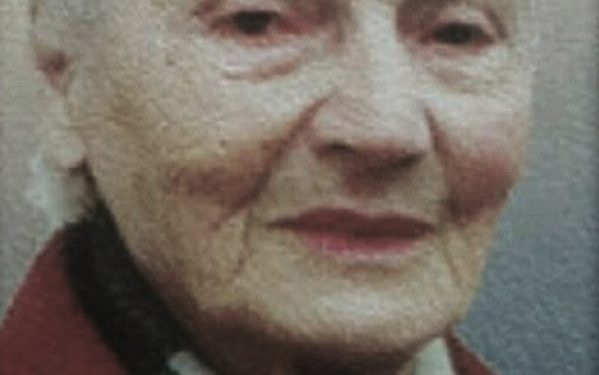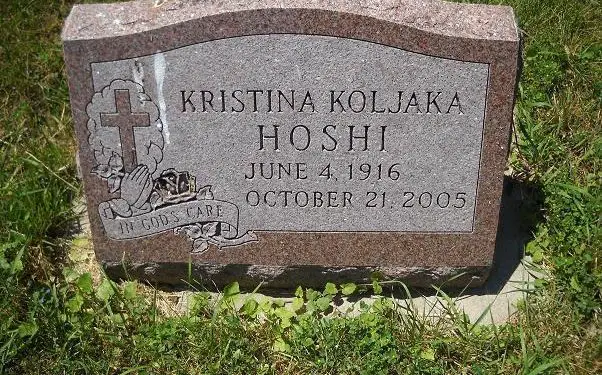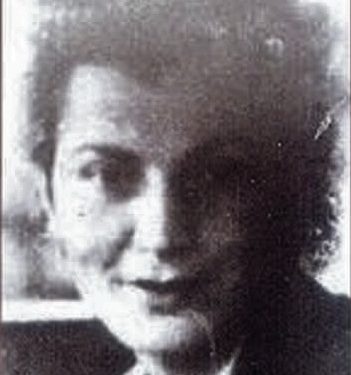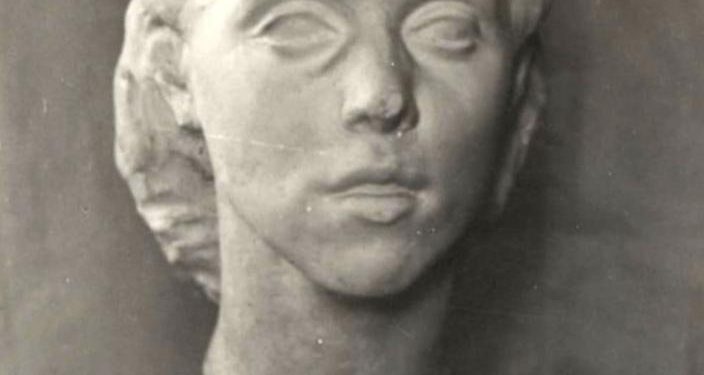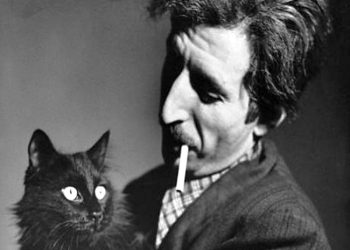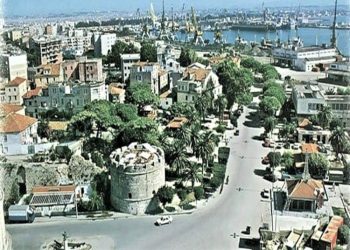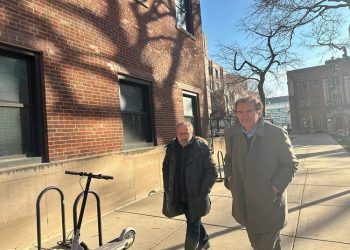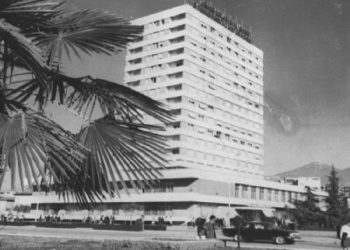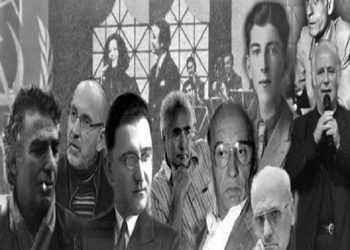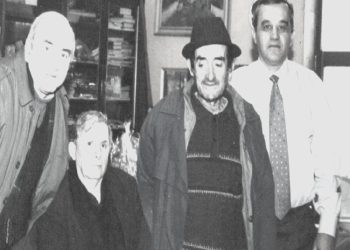By Ylli Xhaferri
Memorie.al / It’s been years since the first Albanian sculptor, Kristina Koljaka, died beyond the sun and sky of Albania, which she loved and desired so much, across the ocean, in distant America. This death could never come to her, who had been doubly alive and mother, who had given blood and milk to the children of her womb, who had given life and vitality to clay, stone and wood, marble and alabaster, the bronze of the motherland, which had ignited the passion of the students for the frozen beauty that with their chisel carved the harsh face of human suffering and joy.
And she died without an Albanian word, without the help of her fellow citizens of Kavaje who loved and respected her like a mother and sister, she was taken to her last home without the comforting hand of the students Muntaz Dhrami, Hektor Dule, Fuat Dushku, Arben Basha, Fitim Sula, Musa Qarri, Luan Berhami, etc. Christina is not. Muses and nymphs dance no more! The clicks of her chisel echo throughout Albania. The bells for its extinguishing in this wintry silence. Her monumental creations, wherever they are, groan. The hand that conceived them with love and devotion was withered.
Kristina Koljaka outlined a multidimensional figure, as a human-sized person she reminds us of Mother Teresa, while as an artist Vera Muhinas, the world-famous Russian sculptor. Artists are like white clouds, they stay for a long time in the blue sky, marveling us with the magic of their art, then they dissolve, they float on our horizon. Like rings of air, like wings of a dove. Over the kavaja sky for months, a necklace of white clouds comes from the sea, circles the clock tower and the nearby hill like a necklace of pearls, then as if spreading it with the mythical hand of Konstadin Shpatarak’s “Seed Thrower”, it fills the field, the quiet neighborhoods with a whiteness dairy.
The missing shroud, which the hand embroiderers could not weave on the loom for sister Kristina, which took their name from them, but also gave them fame by themselves. It is the troubled soul of the elite artist who does not rest, does not find peace and tranquility far from the horizon of the painter. She cannot be occupied by an open grave in a foreign land, she has plasmed life, like a modern Eve, she maintains the right of motherhood in the land that became her cradle, but unfortunately not a grave for giving birth. Kristina had an impulsive voice that never acknowledged fatigue and never lost hope.
He experienced a terrible tragedy, the killing of his uncle by the Cubans of Haxhi Qamili. Jani Koliaka, this contemporary and age of the actor worthy of Hamlet, Aleksandër Moisiu, separated his two daughters from the closed life and the ferexhe, sending them to the “Marcelline” college, in Lecce, Italy. The two years away from Kavaja, gathered endless love and longing in Kristina’s sensitive soul, as well as the plains near Qerret, where she lost herself for hours listening to the sound of the sea waves.
The little girl’s dreams were riding the Adriatic, running barefoot towards the city that had been engraved in her heart. With the opening of the American college in Kavaja, Kristina returned to her hometown. Her first studio became the popular costumes of the Kawaian citizens, which shone as if the rainbow itself had sat on them, the marble dimmies washed in silver, evidence of culture and pride for the aristocratic spirit, the volumes and shapes of the landscape that created the welcoming sweetness, the small and intimate buildings, the varied colors and scents of the flowers that the housewives planted on the windowsills and idyllic balconies, the pastoral surroundings of Fosa and Leshniqa
She did not miss going to the clay masters who gave shape and spirit to the clay with their golden hands. Before her clay-toned hands she felt the magic of creation. The lack of stone in the flat city in the third millennium inspired its fellow citizen, the writer Halit Shamata, to create the unusable purgatory, in the novel of logical absurdity “Two Manuscripts”, where a rake of the city’s quarologist and pustologist, the historical and artistic consciousness of city, inspired Kristina as well. Nature had abundantly blessed the city with plastic clay, the craft of processing which was everyone’s skill.
The dolls that Kristina modeled were baked in the ovens of pans, pitchers and pots, with parental care from adults. It was they who first promoted her art. Seeing his daughter’s talent, her father sent her to the Artistic Lyceum of Rome, where she was a student of the painter Bataglia. Here he met and made friends with the Shkodran painter Zef Kolombi. Kristina fell in love with the sculpture, the decoration that was so dear to her fellow citizens, she could not forget the icons and mural frescoes in the Church of Shënepremte, the plastic and the volumes of classical art.
She embraces the motto of Moses the Great, “I wrestle with good and evil, with meek and violent for the work, until it is filled with my blood and my breath. We mention the works of 1933: ‘Nude’, ‘Portret djali’, ‘Eros’, ‘Little Saint John the Baptist’, etc. In 1934 he returned to his homeland. She starts working as a teacher at the “Queen Mother” School in Tirana. She makes friends with her students Musine Kokalari, Vera Blloshmi and Safo Marko. It becomes for them the parable that they had to follow. Her moral was in the strength, the authenticity of herself and the work.
Carving reality, penetrating it, breathing life into it, she 3 was highly moral, extremely true, completely believable. In 1938, he left Albania for the third time. Attends the Academy of Fine Arts in Rome, majoring in classical art. Vangjush Mio, Andrea Mana, Ibrahim Kodra had finished their studies there before her. Kel Kodheli, Nexhmedin Zajmi, etc. Creates the gallery with the portraits: ‘Nerina, Nudo’ (Diploma thesis in plaster), ‘Portrait of African Shipion’, etc. In 1941 he returned to his homeland. He lives in Korça, where he marries and creates a family.
During the difficult years of the War, he devoted himself to the upbringing of his son and the self-improvement of art, which he would never give up despite the tribute he had to pay. After the liberation, it suffers the terror of the line of the masses, the disdainful collectivity. To earn a living, she works as an advertising designer for cinemas and as a private tailor. He experiences the second tragedy, the massacre of his father in 1947, by the communists, the engineer Jani Koliaka, the polyglot who knew 12 languages, the patriotic intellectual who refused to wear the fascist shirt, but faced the exiles of the time.
Followed like most large families. Her life was marred by social and family strife. A large number of people use the best part of their lives to blacken the lives of others. Face the absurdity of the Albanian gulag. He gets his strength like “Anteu”, as soon as he touches clay and marble.
In 1960, he was appointed a lecturer at the Higher Institute (three years) of Figurative Arts. Her experience becomes a great school for the younger generations. “With velvet eyes, gentle, dear, with a mother’s look, clean speech, an example of accuracy, with her advice and remarks, she used to kill us with cotton wool”, ex-lyceum student Fitim says nostalgically about her. Sula
Besides pedagogy, Kristina creates. Her art takes on new dimensions. Exhibits and wins various awards. Her works are placed in the squares and parks of Albania. Mention: ‘Nursery’, ‘Children and the pigeon’, ‘Doctor Shiroka’, ‘Ballerina’. “Dora D’Istria”, etc. Her titanic passion for sculpture could not be extinguished. On April 21, 2000, the “Gratitude of the City of Tirana” was announced. On January 19, 2001, the City Hall of Kavaja declared him “Honorary Citizen”.
Already at an advanced age and in poor health, she receives as a reward the gratitude and respect so much lacking for her sensitive soul. In the 90s comes her fourth departure from Albania. Goes to America, next to the boy. Although under the shadow of the “Statue of Liberty”, it cannot stay long. The taste of the motherland was missing. “I spoke with the photographs of my sculptures, because the sculptures speak the language given to them by the author. This is how I somehow filled the void that could never be filled. That’s why I came back” she told us.
Among friends it was said: “Woe to you, O sun of Albania”! Only he warmed her icy soul. In the 2000s, he fled Albania for the fifth time. A black news came from across the sea: “Pamporr, o black ship”! Christina is no more. It must have a return. In the land that was made her cradle, her grave should be deepened.
The return is expected. There is a place for him in everyone’s hearts, the land that gave birth to him and raised him will also protect his grave. The sun of Albania will warm it. You must! The necklace of clouds, her missing shroud, will never be unwrapped over Kavaja. May the saint rest in her own land! Don’t wake him up! Her light shines. He left behind the meaning of life and death. It slipped into silence. Art is long, life is short…! Memorie.al




